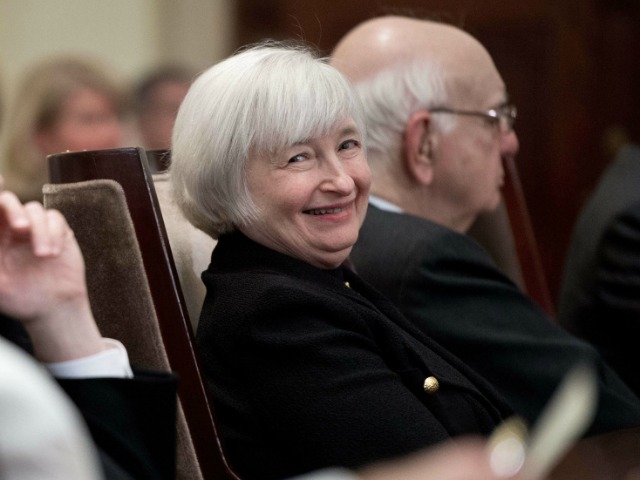
George Orwell wrote in his classic book Nineteen Eighty-Four that “He who controls the past controls the future. He who controls the present controls the past.”
You need no better example of this than the way in which the Federal Reserve Board dissembles in its statements to the public about its policy moves and their impact on the US economy.
In his final press conference as Fed Chairman, Ben S. Bernanke told an audience at the Brookings Institution that “most studies have shown that Quantitative Easing (QE) is at least somewhat effective,” but effective how? Some six years into the Fed’s extraordinary intervention within the US economy, the only thing the Fed has done is transfer hundreds of billions of dollars per quarter from savers and consumers to the largest banks and the US Treasury.
Think about it. The ultra-low interest rates maintained by the Federal Open Market Committee are costing savers about $100 billion per quarter in terms of foregone interest on deposits, according to the FDIC. Here are the actual numbers which were documented in a November 2013 post on Zero Hedge.
If we then figure in the tens of billions of dollars each quarter worth of investment flows taken from private investors and diverted to the US Treasury via QE, just how does this help the US economy? With QE, the Fed is simply lowering the federal budget deficit and bailing out our useless national Congress.
Of course, the economists who populate the FOMC claim in their public statements that QE is helping the housing market. By purchasing tens of billions of dollars’ worth of mortgage securities, so the economists claim, the Fed is helping the housing sector to reflate. But is this really true?
In fact, demand for mortgages and existing homes has been falling for months. The Mortgage Bankers Association Index for new loan applications is down 15% compared with last year. While many analysts and media pundits blame the modest increase in interest rates for the sharp drop in mortgage volumes, in fact past periods of increasing interest rates have had little impact on home lending. Sam Khater at CoreLogic explains what is happening to housing in a blog post:
There have been other instances of similar rate increases during the last 20 years that didn’t lead to a drop in applications. The largest two-month increases in the 30-Year FRM over the last 20 years were in the spring of 1994, summer of 2003, and spring of 2004. All three generated very minor declines in purchase application activity on a year-over-year basis. The difference between today’s market and those eras is that in the past borrowers would often switch to more affordable ARM products, many of which today are less available. The December drop in applications reveals that purchase market today is more sensitive to a rise in 30-year FRM rates than in prior years because borrowers are less able to switch to more affordable products.
As we’ve noted in past Washington & Wall Street comments, many of the mortgage products that existed prior to 2007 have been legislated out of existence by the 2010 Dodd-Frank law. So while Chairman Bernanke and the rest of the FOMC may think that buying mortgage bonds is helping the housing sector, in fact the only beneficiaries are large institutional investors and banks. The new regulations put in place under Dodd-Frank and the new Basel III capital rules have greatly constricted the availability of credit to the housing sector.
Bernanke also commented on whether the Fed’s low interest rate policies are causing new bubbles in the financial markets. He dismissed worries about asset bubbles and said that market valuations are in line with “historical ranges.” However, renowned market analyst Marc Faber told CNBC this week that the Fed’s policies are creating a huge future risk to the US economy:
I think we are in a gigantic financial asset bubble. But it is interesting that despite all of the money printing, bond yields did not go down. They bottomed out on July 25, 2012 at 1.43% on the ten year. We went to over 3% and we are now at 2.85% or so. Now this hasn’t had an impact on stocks — yet. In fact, it pushed money out of the bond market into the stock market. But if the ten year goes to 4.5% or 5%, that will hit the US economy very hard.
Of course, Chairman Bernanke and his colleagues on the FOMC are not afraid to dissemble when it comes to the true condition of the economy because their ultimate goal is to encourage confidence. If people are confident, so the neo-Keynesian playbook goes, they will borrow and spend. Ridiculous concepts like the “wealth effect” are popular with economists for the same reason. See my conversation with Martin Feldstein on Bloomberg Television earlier this week.
The “wealth effect” belongs in the same category as the Tooth Fairy and Santa Claus. If consumers have no income thanks to the Fed’s financial repression and no access to credit thanks to Dodd-Frank over-regulation, it is hard to fulfill the hopes of well-intentioned economists. The fact is that the current mix of Fed policies is discouraging job creation and credit growth, and this hurts consumer spending. Until the folks on the FOMC begin to take a different view of the economy, the outlook is for more of the same.

COMMENTS
Please let us know if you're having issues with commenting.